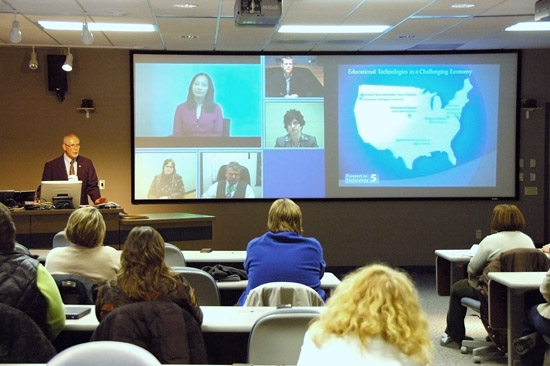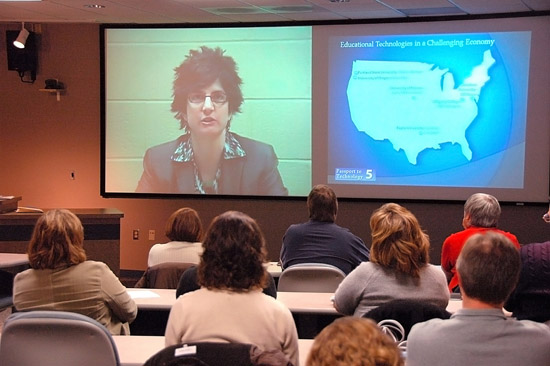Key Takeaways
- Technology in higher education can be a double-edged sword, with the potential for transforming learning but sometimes at an unexpectedly high cost.
- Different perspectives from technology practitioners and stakeholders help us better understand our pursuit of technologies that can transform teaching and learning from passive to active engagement.
- Adopting targeted technology strategies, to explain or change perceptions through effective communications with constituencies, can help institutions not just grow, but thrive.
This article is based on a national video conference and webcast hosted by the University of Wisconsin-La Crosse in January 2009. The event was part of the university’s Passport to Technology, which brings faculty members and administrators together for demonstrations and to share ideas on the effective use of technology in higher education. The entire teleconference, entitled, "Educational Technology in a Challenging Economy," is available online. The topic was also presented at the EDUCAUSE Western Regional Conference in San Francisco.

Jim Jorstad Moderates the Webcast on Educational Technologies at University of Wisconsin-La Crosse
Technology in higher education can be a double-edged sword, both for faculty and administrators. It offers the potential of transforming and enhancing the educational process, but it can just as easily come at an unexpectedly high cost. This dilemma gives new meaning to the phrase "bleeding-edge technology." A failing or depressed economy adds pressures on the ability to purchase innovative new technologies that might aid in the academy’s success. Does technology really improve learning, and at what cost today as well as tomorrow? Can specific educational technologies actually help colleges and universities navigate the turbulent waters of a rough economy?
Learning from the Experts
In the December 2008 issue of Information Week, Bob Evans listed the top 10 issues for CIOs in 2009, with "customer-facing innovation" as the top issue. He foresees a shift from passivity in dealing with customers to a "more-active and engaged" relationship. The third most important issue is the challenging economy itself, and the fourth is the need for CIOs "to make some time to continue finding additional ways to enhance their role as a strategic business leader within the organization." Evans recommends reading two InformationWeek blog postings: John Soat’s "Tomorrow's CIO: The Qualifications" for what CIOs should be doing, and Howard Andersen’s "Two Flavors of CIO, Each Leaving An Aftertaste" for what CIOs should definitely not be doing.
Sharon Blanton, CIO at Portland State and one of the webcast presenters, deals with these issues every day. She stressed the "need to be informed about the state of the economy, but at the same time we need to embrace our cooperative environments to be successful." She continued by saying we need to "listen, hear, and empathize" with our staffs as well as our clients. In a sense, we need "uncommon thinking for the common good," a strategy employed by EDUCAUSE. Blanton said that we need to move from a passive to an active environment. Using our Web 2.0 tools, such as social networking, blogs, and wikis, will help us gain a different perspective on how we can effectively use these tools in teaching and learning. In a sense we have to change our perspectives or points of view as we employ different technologies.
Challenging the Library
Librarians are equally concerned by the costs of technology to serve their clientele. Webcast presenter Bill Mayer from American University is working to challenge the traditional role of the library and the librarian. As Bill pointed out, "We need to be as efficient as possible, but at the same time we have to change the perception of the library from the traditional warehouse to a more active learning space."
Some might not consider Mayer a typical librarian. As he said, "Librarians are wonderfully capable of developing services that nobody wants or needs." Instead Mayer suggested that we think about what we are doing, and to know when we have to say no. He advised librarians to go to the classroom rather than have faculty and students come to the library first.
Throughout the school year, Mayer has come up with innovative concepts such as "dinner with a librarian" or embedding librarians in untraditional spaces. Clearly American University is working to reshape the perception of what a librarian does. Mayer concluded by saying about his role as a librarian, "as an on-line shepherd, we have to get students to understand that Wikipedia is a starting place, not an ending point."
Getting the Administrative Perspective
Technology from an administrative point of view can yield yet another perspective. Jenny Mehmedovic, assistant to the provost at the University of Kansas, has seen this firsthand. The question for campus leaders is whether IT is viewed as a black hole or if it can be seen as a mechanism that can save time and money. The economy forces us to make careful decisions, and Mehmedovic recommends that we maximize spending in a more coordinated way. The University of Kansas has accomplished this by making more resources available online. "One way we have saved time and money is to put all of our policies online," commented Mehmedovic, so people don’t have to endlessly search for information when they need it. Technology can help stretch budget dollars further as economic pressures continue to increase. By finding ways technology can help us save, we can "shine a light on the perception that IT is just a black hole."

Jenny Mehmedovic Speaking During the Webcast
In an environment of extreme budget trimming, innovation can be one of the first areas cut. Rick Holmgren, executive director of Learning, Information, and Technology Services at Allegheny College, insisted that "you don’t stop innovating when dollars are tight." He pointed out that "innovation is not just new stuff but it can also refer to processes. If we improve access for students, make it more efficient, and reduce complexity, we can improve productivity."
Increasing Student Access
In considering how to provide increased access to teaching and learning for students, a topic of major interest is the creation of learning spaces and learning commons. Some institutions might consider reducing their project scope or plans for new teaching and learning spaces, but webcast presenter Helen Chu emphasized the need to increase student access for instruction with an eye on economies of scale and centralization of learning spaces to increase efficiencies. Chu is the director of academic technology at the University of Oregon.
Chu recommended developing services that are scalable, financially sound, and sustainable for the long term. If cuts are needed, they should be strategic, not across the board. Chu subscribes to the philosophy of the Obama Administration in "looking for proposals that leverage the immense transformative power of technology and innovation." She summed up her philosophy of technology in a challenging economy by stating, "A crisis is a terrible thing to waste."
Communicating Effectively
In academia, on occasion we forget the importance of effective communications to our staff and our stakeholders. Many strategic plans identify communication as an important element for institutional success. As educational institutions focus on leveraging technologies to survive in difficult economic times, how we use technology to improve our communication takes on increased importance. One method to enhance our ability to communicate more effectively is through improving our technology literacy. Some practitioners stress that being visual artists as we communicate through technology can increase our likelihood of success in both favorable and challenging economic times. Being visual artists may actually help us to become better communicators. Gardner Campbell of Baylor University explained how he hears America’s students, faculty, and staff "crying" due to a myriad of challenges in using and understanding technologies in higher education. Campbell suggested, "We can’t just bolt the new literacies onto the old. We have to ‘re-imagine’ what it means to be literate, to be a citizen, to be an intellectual in a learning community." In essence he challenged webcast participants "to be serious artists if we are to use technology to teach, to learn, and communicate."
The creative webcast Deep Thoughts on Technology Literacy helps illustrate the importance of technology literacy by using rich new media to communicate in any economic environment.
Finding Strategies to Survive and Grow
As educational institutions cope with challenging economic conditions, it is important to be proactive in deploying technology solutions. Five core strategies help us survive and grow.
- Communicate goals and publicize success. Institutions should focus on communicating their mission, vision, and goals to both internal and external constituencies. In addition, technology practitioners should publicize success stories both on and off campus. This helps raise staff morale along with promoting cost-saving measures and successes to administrators, and in particular to legislatures. Graphically explaining the return on investment (ROI) in both capital and personal terms can yield great dividends.
- Use technologies to explain or change perceptions. Institutions need to diligently use innovative technologies to dispel myths and tell their stories. Simply creating a traditional website is not innovative or engaging. Asking strategic questions such as how Web 2.0 technologies can help audiences find information quicker or more efficiently is more precise. Using rich media and technology to reach a wider audience is also useful, and telling the stories behind the numbers can be very effective. For examples of engaging stories for internal and external audiences, go to http://www.uwlax.edu/edtech/ and click on "Stories behind the Numbers" at the right side of the screen.
- Promote cost- and time-saving opportunities. When ideas for cost or time savings are suggested, make sure all campus communities learn about them. Fostering innovative thinking and circulating ideas widely can generate even more solutions.
- Publicize academic and administrative successes. Educators and academic institutions typically have daily success stories that are not shared with on- or off-campus communities. Developing a systematic way to market faculty, staff, and student successes typically breeds more success. In addition, it helps decision makers understand campus needs and the potential benefits of strategic investments in technology. Using stories with supporting empirical data will strengthen the message in all economic environments.
- Redefine, reuse, and recycle. In considering any of the strategies discussed, using what works best or combining them can yield even more innovation. Having a nimble, well-thought-out plan that can be modified as economic conditions change and being prepared, yet flexible and open to change, can point any institution in the right direction.
An economic crisis offers an opportunity for higher education to redefine how we use technology for many aspects of teaching and learning. While the economy could fundamentally change how universities and colleges spend their technology dollars, at the same time we might find that new strategic thinking helps us survive and even thrive. Perhaps educational technologies will be the tool that makes the weak economy not so challenging for higher education after all.
© 2009 James A. Jorstad. The text of this article is licensed under the Creative Commons Attribution-NonCommercial-Share Alike 3.0 license.
